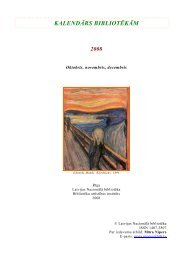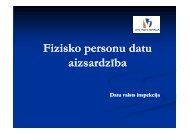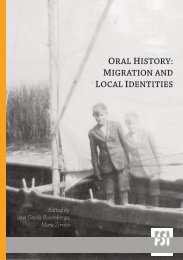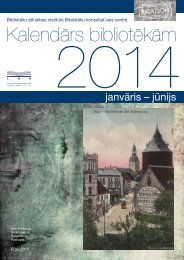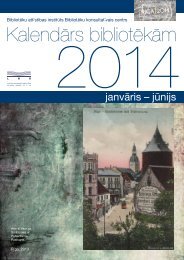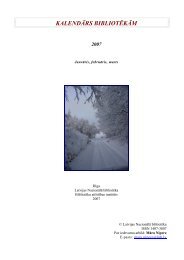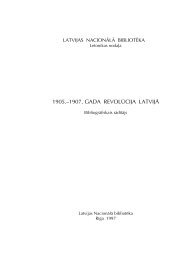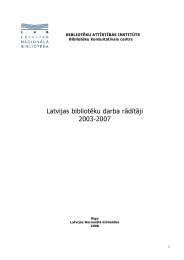LAIKU ATŠALKAS: ŽURNĀLISTIKA, KINO, POLITIKA - Academia
LAIKU ATŠALKAS: ŽURNĀLISTIKA, KINO, POLITIKA - Academia
LAIKU ATŠALKAS: ŽURNĀLISTIKA, KINO, POLITIKA - Academia
You also want an ePaper? Increase the reach of your titles
YUMPU automatically turns print PDFs into web optimized ePapers that Google loves.
<strong>LAIKU</strong> ATŠALKAS: ŽURNĀLISTIKA, <strong>KINO</strong>, <strong>POLITIKA</strong>Ilze ŠulmaneResearcher, University of Latvia, Department of Communications StudiesPRESS JOURNALISTS IN LATVIA: AMONG SYSTEMS,INFLUENCES, PRACTICESKeywords: Daily press, media models, culture of journalists, post-Soviet journalism, professional rolesThis paper is based on studies of journalists which were conducted between the late 1980sand 2007. The author has analysed the results of these surveys, and she has also conducted indepthinterviews with journalists at six daily newspapers, thus trying to link the micro and macrolevel in journalism, as well as to identify elements of media models as seen in the discourse ofindividual journalists about professional values, the role of the media, journalistic practices,professional identities and ethics.An important cultural barrier in this regard is that there are media outlets in Latvia in twodifferent languages. It is also true that the Russian information space is easily available in Latvia,and this cannot help but have an effect. Among economic barriers, there is the small anddivided market, along with the consolidation of media properties, which reduces the diversityof media content. There is also the problem that high-quality media content costs money. Thepresence of significant competition has encouraged external, not internal pluralism in mediacontent, as well as a split in the professional environment. The studies show that Latvian andRussian journalists lack unified professional criteria to evaluate journalistic practices. Specificissues about professional practices, as opposed to ideal and normative values, lead to more openand diverse answers.The interviews with daily newspaper journalists revealed a market-oriented approach, a senseof mission in terms of serving the needs of the public (or some segment therein), as well as thebelief that the press can be used as a political weapon, with the roles of politicians and journalistsbecoming merged.The discourses of journalists point to all three of these media models. The liberal model ismarked out by declarations from journalists, elements of internal pluralism at individual mediaorganisations, relatively strong professionalization (without an organisation), and the fact thatjournalists do admit to commercial pressure which limits their autonomy. The existence of thepolarised pluralistic model is evidenced by the high level of political parallelism and the factthat journalists focus on political life, formulating commentary as defenders of the public, thelow level of professionalization at some publications, external pluralism, a failure to separatebetween journalistic and political activities, and the citing of the media situation in Italy as apositive example. The democratic corporative model is seen in commentary-focused journalismwith an emphasis on professionalism, the desire of journalists to have a formal organisation,and the fact that journalists hope to have a developed and high-quality newspaper industry withcompeting publications in both languages.219



